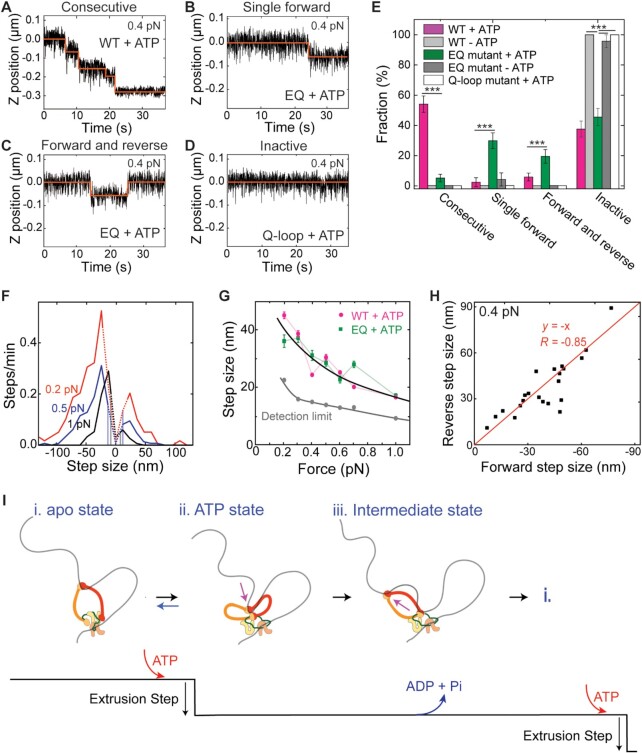Figure 4.
ATP-binding of condensin induces a single step in DNA loop extrusion. (A–D) Representative trajectories for (A) consecutive DNA loop extrusion steps, (B) a single forward step, (C) a single forward followed by a reverse step, and (D) an inactive trajectory, all probed in the presence of ATP. (E) Observed fractions of different stepping behavior (N = 85, 96, 77 and 18 for wild-type with ATP, without ATP, EQ mutant with ATP, and Q-loop mutant with ATP, respectively). Statistical analysis consisted of an unpaired two-tailed t-test (*** indicates P< 0.001). (F) Step size distributions of the EQ mutant in the presence of ATP at different DNA stretching forces (0.2 pN: N = 154; 0.5 pN: N = 186; 1 pN: N = 106). Dotted lines denote step sizes below the step resolution limit. Data for other forces are provided in SI. (G) Step size in nm (median ± SEM) for WT (magenta) and EQ mutant (green) versus applied force (0.2 pN: N= 69; 0.3 pN: N= 53; 0.4 pN: N= 73; 0.5 pN: N= 74; 0.6 pN: N= 45; 0.7 pN: N= 58; 1 pN: N= 76). Forward and reverse steps were pooled together in these data. Solid black and grey lines represent guides to the eye. (H) Scatterplot of reverse step sizes versus the corresponding preceding forward step sizes (N = 15) for the EQ mutant at 0.4 pN. Red line depicts a linear fit,  . Pearson correlation coefficient R = −0.85. (N = 22) (I) Proposed working model for the condensin conformational changes during the ATP hydrolysis cycle. (i) Condensin holocomplex is anchored to DNA by the Ycg1-Brn1 subunit. In the open configuration, the hinge domain binds DNA. Note that the hinge grabs an arbitrary nearby location within the randomly structured DNA polymer coil. (ii) Upon ATP binding to condensin, the SMC ring changes from the open to a collapsed (butterfly) configuration, generating a single DNA loop-extrusion step where DNA is reeled in via the hinge movement. From our data, we conclude that this step is in principle reversible, whereby state ii can return to state i. (iii) After DNA transfer to the globular domain of condensin, the hinge is released, presumably during ATP hydrolysis, whereupon it is available to bind new DNA for the next step in the cycle. Upon repetition of this cycle, DNA is extruded into an expanding loop in consecutive steps.
. Pearson correlation coefficient R = −0.85. (N = 22) (I) Proposed working model for the condensin conformational changes during the ATP hydrolysis cycle. (i) Condensin holocomplex is anchored to DNA by the Ycg1-Brn1 subunit. In the open configuration, the hinge domain binds DNA. Note that the hinge grabs an arbitrary nearby location within the randomly structured DNA polymer coil. (ii) Upon ATP binding to condensin, the SMC ring changes from the open to a collapsed (butterfly) configuration, generating a single DNA loop-extrusion step where DNA is reeled in via the hinge movement. From our data, we conclude that this step is in principle reversible, whereby state ii can return to state i. (iii) After DNA transfer to the globular domain of condensin, the hinge is released, presumably during ATP hydrolysis, whereupon it is available to bind new DNA for the next step in the cycle. Upon repetition of this cycle, DNA is extruded into an expanding loop in consecutive steps.

